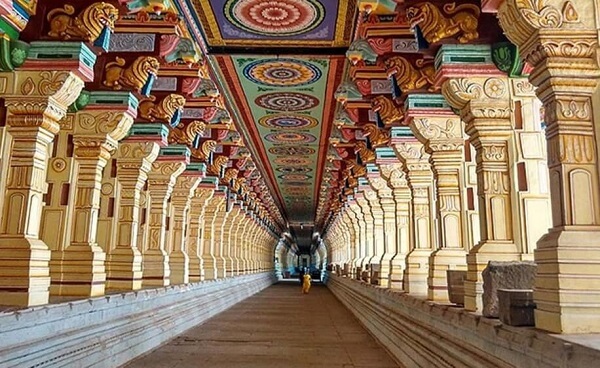
12 Jyotirlinga Tour Packages: Rameshwaram Jyotirling Temple
Ramanathaswamy Temple at Rameshwaram is an important tirth yatrasite for the followers of Hinduism. It is believed that a visit to this temple washes away one's sins and brings salvation (moksha). Located on an island off the Sethu coast of Rameshwaram, Ramanathaswamy Mandir can be reached via Pamban Bridge across the sea. Being situated in Rameswaram, the shrine is popularly known as Rameshwaram Temple. Rameswaram is a town in Ramanathapuram district of Tamil Nadu. The town is particularly famous for its religious shrine of Ramanathaswamy. The nearest airport to Rameshwaram is located at Madurai, which lies at a distance of 163 km. One can easily reach Rameshwaram by taking regular tourist buses or by hiring taxis from all the major cities of Tamil Nadu including Madurai, Chennai and Trichy.
The construction of this temple began in the 12th century; nonetheless, it was completed much later, during the reign of various rulers. Rameshwaram Temple is famous for embracing one of the Twelve Jyotirlingas (lingam of light) of Lord Shiva. The temple is also accredited for being the southernmost 'jyotirlinga' of India. It is believed that at this place Lord Rama offered his gratitude to Lord Shiva.
The Lingam of Ramanathaswamy is the presiding deity of Rameswaram Temple. The religious significance of this shrine has made it, one of the most visited temples of India. Rameshwaram (South) is one of the four major tirth yatrasites of Hindus, the other being Puri (East), Dwarka (West) and Badrinath (north). The main shrine adores the idols of Viswanatha Naicker and Krishna Naicker.
In the inner section of the Ramalingeshwara, Ramalingam and Vishvalingam are placed side by side. Preserving the words of Lord Rama, Vishvalingam is worshipped before Ramalingam. Maha Shivarathri, Thirukalyanam, Mahalaya Amavasai and Thai Amavasai are the major festivals that are celebrated with gusto and fervour.
LEGEND
Ramanathaswamy Temple is closely linked with the great epic Ramayana. As per the legend, it is believed that Lord Rama worshipped Lord Shiva here, on his victorious return from Sri Lanka. As the legend goes, Sages (Rishis) counseled Lord Rama (along with Sita and Lakshmana) to install and worship the 'Shivalingam' at this place, to compensate the sin of Brahmahatya (killing of a Brahmin). Lord Rama approved the idea and fixed a favorable time for the installation of Shivalingam.
Facing time constraints, Lord Rama sent Lord Hanuman (Anjaneya) to fetch a 'lingam' from Mount Kailash. As Hanuman's return was delayed, Sita crafted a 'linga' from sand, and Lord Rama consecrated it. Upon Hanuman's arrival with the 'lingam,' the installation rituals had concluded. Lord Rama comforted Hanuman and placed his lingam (Visvalingam) beside the Ramalinga. Lord Rama further sanctified the Visvalingam, decreeing that rituals be performed first for it. Explore this tale and more with Tirth Yatra India, your trusted guide for an enriched journey.
THE TEMPLE
The temple had humble beginnings with an ancient shrine housed in a thatched hut until the 12th century. The first ever masonry structure was built by Parakrama Bahu of Sri Lanka.The Setupathy (architects and stone masons) rulers of Ramanathapuram completed the rest of the temple. Although manly Dravidian in style some of the temple vimaanams resemble the Vimaanams of the Pallava period. The temple has also received royal patronage from several kingdoms such as Travancore, Ramanathapuram, Mysore and Pudukkottai.Much of the additions were carried out between the 12th and the 16th centuries. The long corridor (3rd prakaram) dates back only to the 18th century.
Stretched over a vast area of 15 acres, Rameswaram Temple is the typical specimen of Dravidian style of architecture. The skyscraping gopurams (spires) truly dominate the skyline of Rameshwaram. The shrine is acknowledged for having the largest temple hallway in India. This pillared corridor extends to 4000 feet in length, embracing more than 4000 pillars. Erected on a raised plinth, granite pillars are intricately carved with beautiful images. A hard fact about this corridor reveals that the rock doesn't belong to the island and it was imported from somewhere across the sea.
The main entrance of the temple tower has many storeys and stands tall. Its structure carvings, statutes and the peaks make people dumb founded. The grandeur of the Lord is really felt here. The human weakness for being narrow-minded is automatically removed and they feel their horizons broadened. On the tall stone pillars of temple, beautiful carvings can be seen. Elephants with their trunks raised are seen. The four sides of the temple are enclosed by strong stone walls. They are 650 ft. and 12ft. wide and tall respectively. This wonderful temple built on the sand island, is a work of great art and very impressive. Near to a gold plated pillar, a river is carved on a monolithic stone of 13 feet high and a foot wide. This indeed is a typical example of beautiful sculpting.
Near the main temple of Rameshwar, there is a separate temple for Parvati known as Parvatavardhini temple. Besides this, there are temples of Santana Ganapati, Veerabhadra Hanuman, navagrahas, etc., At a distance of about nearly 2 kilometers from the main temple, there is Gandhamaadhan mountain. In spite of being a sandy area, it is very green with a variety of flora. This is the Nandanavan of Rameshwar
Places We Visit During Rameshwaram Jyotirling Yatra
GANDAMADANA PARVATHAM
This sacred shrine holds a wheel with the footprint of Lord Rama. The shrine stands on the highest point on the island, around 2 kms from Rameshwaram.
RAMJHAROKA TEMPLE
The footprints of Lord Rama is placed on a Chakra at the Ramjharoka Temple. The chakra has been placed at the highest point of Rameshwaram. This point is at a distance of 5 kms from Rameshwaram town. Since it is the highest point of Rameshwaram, therefore it provides a fantastic view of the blue ocean waters below.
Rameshwaram has many small temples, apart from the main temples, dedicated to Lord Rama, Lakshaman, Sita and Hanuman. Each temple big and small of Rameshwaram does have a history of its own. Other than the temples, there is also a tomb of Saint Ibrahim Syed Aulia at Erwadi, about 24 kms away from Rameshwaram.
DHANUSHKODI
Dhanushkodi is located at the eastern end of the island. It is named after Lord Ram's bow and is at a distance of 8 km from Rameshwaram. The boulders in the sea between Sri Lanka and Dhanushkodi are known as Adam's bridge. It is believed that Lord Rama used them to reach across Sri Lanka. Danushkodi is about 18 miles West of Talaimannar in Jaffna, Ceylon. Before 1964 storm there was a train service up to Danushkodi called Boat Mail from Chennai Egmore, the train linked a steamer to Ceylon. During the 1964 storm a huge wave of about 20 ft came crashing on the town from Palk Bay/Strait east of the town and destroyed the whole town, a train, the Pamban Rail Bridge etc all happened at the dead of the night.
Danushkodi has the only land border between India and Ceylon which is one of the smallest in the world just 50 yards in length on a sand dune in Palk Strait. The Government of Madras declared the town as Ghost town and unfit for living after the storm, now a small group of fisher folk resides there. Buses (Rs 5, hourly) from the local bus stand on East Car St stop about 4km before the beach so you have to walk the rest of the way. Otherwise, an autorickshaw (45 minutes one way) costs Rs 250 return, including one hour waiting time.
Do you have any questions?
Don't hesitate to call us. We are a team of experts and we are happy to talk to you.
Teen Dham 11 Jyotirlinga Tirth Yatra- 34 Days
Main Attractions: 11 Jyotirlingas, Kishor Dham, Ganga Sagar, Nepal, Kathmandu
Departure: 13 July 2025
Ek Dham Jagannath Puri Gangasagar Tirth Yatra- 16 Days
Main Attractions: Jagannath Puri Dham, Baijnath Dham, Gangasagar, Ayodhya, Allahabad
Departure: 26 March 2025 & 03 September 2025
Ek Dham Dwarka Puri Yatra - 12 Days
Main Attractions: Dwarka Puri Dham, Seven Jyotirlingas, Statue of Unity
Departure: Coming Soon
Braj Chaurasi Kos Yatra - 10 Days
Main Attractions: Mathura, Vrindavan, Nandgaon, Barsana, Govardhan Parikrama, Braj Chaurasi Kos Yatra
Departure:16 March 2025








